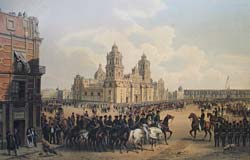Battles of the War
Occupation of Mexico
Despite the doubtful legitimacy of the U.S. war against Mexico, in general the regular U.S. Army behaved with respect toward the institutions and the populace of the country it occupied. This was exemplified in Matamoros, where Gen. Zachary Taylor recognized the city council in office at the time and defended its continuance based on the right of jus gentium. This became a pattern in other Mexican towns, although in some municipalities, such as Tampico and Vera Cruz, the councils dissolved and the U.S. forces became military authorities with civil functions.

While in Jalapa before advancing into central Mexico, Gen. Winfield Scott calmed the population by assuring local authorities that private property, civil liberties and guarantees, as well as the church and religious freedom would be respected and that crime - even that committed by U.S. troops - would be punished. He did, however, declare martial law in order to control relations between his army and the Mexican authorities and population. Nevertheless, in its military actions, the U.S. Army did not hesitate to use its force to the fullest, even if it brought devastating consequences to the civilian population, as was observed in Monterrey, New Mexico, and Vera Cruz. The siege of Monterrey involved ferocious combat that inflicted great material losses on the population. When the inhabitants of New Mexico, led by native Tomas Ortiz, rebelled and killed Governor Charles Bent and five Anglo-Americans, Colonel Sterling Price reacted quickly, attacking the rebels at Taos. The principal leaders were killed and the rest of the rebels dispersed. In confronting resistance and fortifications at the port of Vera Cruz, the U.S. Army and marines implemented an intense bombardment of the city from March 22-26, 1847, causing about five hundred civilian deaths and significant damage to homes, buildings, and merchandise. General Scott and Commo. Matthew C. Perry capitalized on this civilian suffering; by refusing to allow the consulates of Spain and France to assist in civilian evacuation, they pressed Gen. Juan Morales to negotiate surrender.
The U.S. Army, as a warning to cities, townships, and whole vicinities, held civilian populations responsible for damages and losses to its war machine. One such case occurred in the township of Guadalupe, near Mexico City, when the town council was arrested for divesting a U.S. soldier of his weapons and his horse.
After Mexico City was occupied, General Scott officially recognized the city council, which was headed by Reyes Veramendi. He also allowed the continued functioning of the local police and granted that the civil administration continue to take charge of routine court cases, except when U.S. forces were involved or when they took on a political nature. He appointed Gen. John A. Quitman military governor. In consideration for its protection, the U.S. Army charged the city council 150,000 pesos, which was used to care for U.S. soldiers wounded during the campaign. To cover this cost, the city council pledged money from district revenue sources that remained under its control such as customs, the post, tobacco, and direct contributions. As the occupation continued, the U.S. Army increased its authority in some towns by assuming control of public works, jails, and judicial administration and by taking over the collection of various public revenues. In Mexico City, the U.S. military governor authorized gambling and assessed one thousand pesos per table per month.
At the end of 1847, U.S military authorities allowed for the renovation of city hall in Mexico City. This went against Mexican laws and was done purposely to cultivate a city government that would collaborate or accept peace terms, thereby putting pressure on the national government of Mexico, headquartered in Queretaro. Some Mexican politicians were under the impression that if the country were not to lose its autonomy altogether, it must submit to the new U.S. order. One of these was Francisco Suarez Iriarte, who began the movement to renovate Mexico City's city hall. He was named president of the new municipal assembly, one of the first functions of which was to change the city's political definition to that of state. These advantages did not prevent the U.S. occupiers from demanding a new loan of 668,000 pesos, which the municipal assembly was obliged to pass on to the people in the form of a 6-percent tax on revenues and other payments.
Foreign trade, formerly heavily taxed under the Mexican fiscal system, was simplified under U.S. control of maritime customs. The U.S. military levied a low tax, which helped the government finance war costs. The state monopoly on tobacco was also abolished, as well as the tax on domestic trade. During the occupation, the U.S. forces paid for their provisions, which caused a flow of dollars in occupied areas and facilitated the circulation of foodstuffs and merchandise.
U.S. forces caused little disturbance among the locals and conducted themselves well in the churches. They developed a curious language to make themselves understood, especially with the peddlers of fruit and trinkets.Nevertheless the conduct of the U.S. volunteers left much to be desired. After an area was occupied, and there was little left to do, they often resorted to theft and treated the Mexicans abusively. This was plain from the outset of the war, when Texas volunteers preyed on the ranches in northern Tamaulipas and Nuevo Leon. The U.S. Army installed public pillories in Mexico City to punish soldiers and volunteers who disobeyed the law. There, U.S. culprits were flogged along with Mexican offenders.
To amuse themselves in the Mexican capital, U.S soldiers enjoyed the shows at the Nuevo Mexico Teatro and frequented the dance halls on Coliseo and Betlemitas Calles. In the Hotel Bella-Union, they set up a canteen where there were gambling tables and prostitutes. U.S. citizens published various newspapers during the U.S occupation of Mexico, in which they reported the progress of the war, promoted factionalism among Mexicans, and advertised various businesses and shows.










